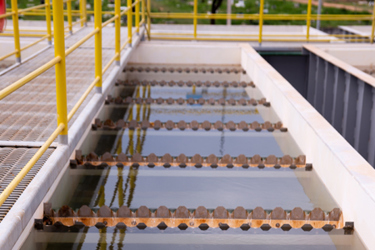Pretreatment Filtration For Small Systems: The Expensive Pitfalls Of Low-Cost Equipment
By John Castro

When seeking bids for a fair comparison, it’s important to evaluate the total cost of ownership.
Pretreatment filtration equipment can last for five years or 30. It can require constant demands on a maintenance crew or hardly any at all. It can vigilantly protect expensive downstream filtration systems or expose them to the damaging effects of under-filtered water. It can effectively remove regulated contaminants from wastewater or release them into the environment and create a compliance violation, public nuisance, or worse.
For many small treatment systems, the lure of cheap prefiltration and discharge filtration equipment can be strong. Small systems are especially budget-conscious, so a low price tag can be tempting. But small systems often are not able to absorb the inefficiencies and maintenance demands that can come with buying low-quality equipment. To truly understand the full cost of a pretreatment system, end users and their engineers need to perform an essential calculation to arrive at the total cost of ownership.
Asset Costs: More Than Just The Price Tag
The upfront equipment cost is only the first part of the total cost. Facility operators also should understand the full spectrum of costs specific to that equipment: operational costs, maintenance costs, repair costs, customer service costs, and the length of equipment life. Before making a large equipment purchase, all of these predicted expenses should be evaluated in advance so that the budget-conscious purchaser can be assured that they are securing the lowest total cost of ownership. Here are a few field examples of how these kinds of costs can make cheap equipment expensive to own.
Operational Costs: Will The Equipment Drive Up Energy Consumption?
There are many ways in which inexpensive, low-quality equipment can drive up operational costs, and the biggest one concerns energy use. Cheap equipment may reflect a low investment in product engineering and design, which can have some unfortunate consequences for customers. If an underdrain is not designed to be hydraulically balanced, for example, this will cause greater pressure drop and dead spots in the media bed, which in turn causes greater strain and demand from the pump and greater power consumption.
As solar becomes more mainstream, tapping this resource can deliver additional energy savings — if vendor equipment enables it. The ability to implement various technologies such as solarpowered instrumentation can remove on-site power requirements and drive down both installation and operational costs.
Maintenance Costs: Will The Vessels Be HighMaintenance?
The maintenance required to keep low-cost prefiltration equipment performing at optimal levels can be much more demanding than it is with high-quality equipment. For example, weathering, warping, and cracking of underdrain materials are more common with less-expensive pretreatment vessels, either because they are constructed with inferior materials like PVC plastic or because they are difficult or impossible to replace. Make sure that vessel underdrains are constructed of high-quality materials and easily replaceable, which can reduce maintenance demands and labor hours.
When reviewing a potential product, the devil may be in the details. Look at the manway lid-fastening hardware, for another example. Does its design allow for easy removal and assembly while maintaining a safe design? Or will it be a hassle for maintenance crews, potentially hurt somebody, or worse? If you spot a respective part that was clearly designed to help maintenance workers do their jobs safely and more easily, it’s a good sign that the rest of the product has been designed similarly. Another feature to inspect is a side manway: Is one available and if so, how large is it, and will it enable easy operator access to underdrain for inspection and maintenance?
Repair Costs: Will The Cost To Fix Outstrip The Purchase Savings?
A good indicator of potential repair costs can be found in product literature. Owners and engineers should review maintenance and operation manuals to assess how much detail is provided and how easy the manuals are to read and navigate, which can give insight into how easy or difficult it may be to make a repair or conduct routine maintenance.
The length of warranty can give another clue to future repairs. The longer the warranty, the greater indication that the vendor fully stands behind the quality and reliability of its products. Beware of shorter warranties, which should signal to customers that the company does not intend to be a long-term partner.
Customer Service Cost: Will There Be Any Vendor Support When Issues Arise?
For low-cost equipment, there may be little to no customer service or a lack of understanding of the filtration equipment and its operation. When engineers and operators are on their own to figure out why a system is no longer working well or working at all, this could require significant staff time and resources to run down a problem and find a solution. Confirm that the vendor supplies a technical support phone line through which facility technicians can troubleshoot with vendor engineers and avoid a costly site visit. If there is no tech support number, consider that a red flag.
Equipment that comes with robust customer service and engineering support can be worth the extra purchase price on its own. Companies that offer comprehensive project delivery from design to deployment will be of great value to engineers and end users, because the depth of knowledge and experience built into every stage can deliver the guidance, training, and support that smaller systems often need.
Lifespan: How Many Years Will The Equipment Last?
Parts and equipment that use high-quality materials and construction techniques will result in longer product life and deferred capital expenses. One primary example is the simple specification of thickness of vessel heads and side shells. Just investing in a thicker-gauge tank material can dramatically extend product life while minimizing repair costs, labor, and downtime.
A system lasting 20 years is worth at least four times the cost of a system that will need to be replaced in five years, and small treatment facilities can often get this shelf life with a small purchase price premium — not four times the cost.
Always Think Beyond The Purchase Price
For small systems, the decision to buy pretreatment filtration equipment should never rest on sticker price alone. While the allure of low upfront costs can be powerful, these systems often bring hidden burdens in the forms of higher energy demands, frequent maintenance, unexpected repair bills, limited technical support, and premature replacement. By carefully evaluating the total cost of ownership, factoring in operation, maintenance, repair, customer service, and lifespan, engineers and operators can make smarter investments that deliver reliability, compliance, and long-term savings. In the end, selecting high-quality equipment is not just a budget decision; it’s a safeguard for system performance, environmental protection, and the financial sustainability of the facility itself.
 About The Author
About The Author
John Castro is the industrial, commercial and municipal regional sales manager covering the western United States for Yardney Filtration Systems. He can be reached at jcastro@yardneyfilters.com.
